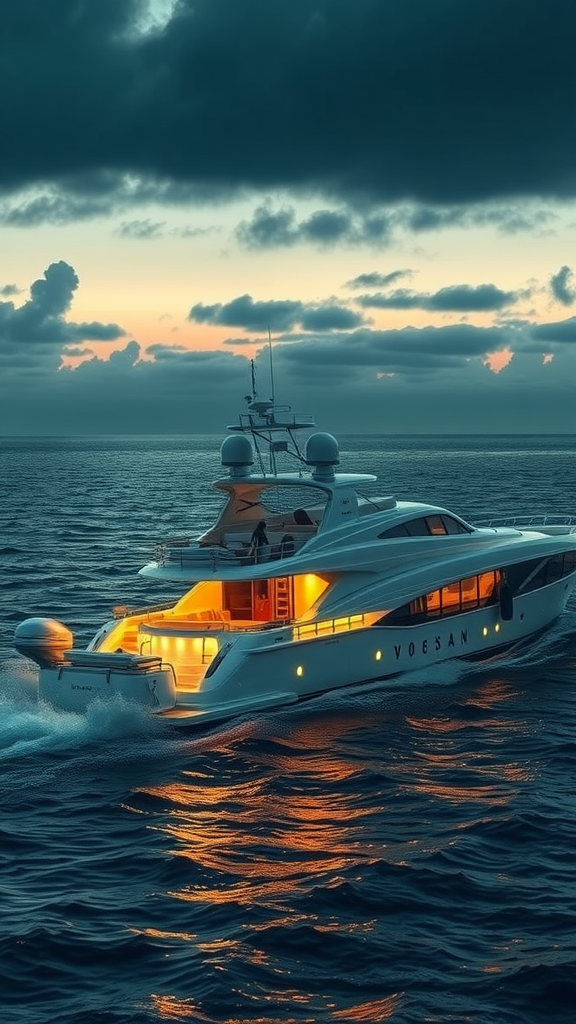The Impact of the Venus Yacht Crash on Maritime Safety Regulations
The incident involving the Venus yacht crash has raised significant concerns regarding maritime safety regulations. As one of the most high-profile yacht incidents in recent years, it has prompted both industry professionals and regulatory bodies to reassess policies designed to ensure safety on the waters.
The crash occurred in calm waters, but the circumstances surrounding it have highlighted serious gaps in current regulations. Eyewitness reports describe the yacht’s sudden maneuvers and subsequent collision with another vessel. This has led to scrutiny over the existing safety standards that govern yacht operations and crew training.
Following the crash, several key areas in maritime safety regulations have come into focus:
- Navigation and Communication: The incident has underscored the need for improved systems for navigation and communication between vessels. Many mariners utilize outdated technology which can hinder efficient response times in emergency situations.
- Training Standards: The qualifications and training of yacht operators have come under fire. There are calls for enhanced training programs that better prepare crew members to deal with unexpected emergencies and navigate complex water conditions.
- Vessel Inspections: The safety of yachts often relies on regular inspections and maintenance. The Venus yacht crash has prompted discussions about stricter inspection regulations to ensure yachts are seaworthy before hitting the open waters.
- Safety Equipment: There are growing concerns about the adequacy of safety equipment aboard yachts. Post-crash investigations have revealed that some yachts may not carry essential safety gear, raising an important question about compliance with maritime safety regulations.
- Incident Reporting: The crash has also revealed a need for better reporting systems for maritime incidents. Clear protocols can help in investigating accidents more thoroughly, promoting accountability among yacht operators.
In the wake of the crash, regulatory agencies around the world have begun to implement changes. These adjustments aim to enhance safety measures to prevent similar incidents in the future. Some proactive steps being discussed include:
- Revising the existing maritime regulations to include specific guidelines for yacht operations.
- Establishing mandatory training sessions focused on safety protocols for yacht crews.
- advanced technology such as GPS and collision avoidance systems on all commercial and recreational vessels.
- Creating a centralized database for tracking yacht inspections and incidents to foster transparency in safety practices.
Maritime safety experts stress that regulatory changes need to be evidence-based. The Venus yacht crash serves as a critical reminder of the potential risks associated with operating vessels in any conditions. As discussions unfold, it is essential for the maritime community to anchor their strategies in data and real-world effectiveness.
Additionally, raising public awareness about the importance of safety on the water is crucial. Promoting safety education initiatives can empower yacht users to take personal responsibility for their safety and that of their passengers. Educating the public on recognizing dangerous conditions and understanding safety equipment can lead to a more vigilant maritime environment.
The Venus yacht crash has marked a pivotal moment in the maritime industry. Its ramifications extend beyond just one tragic incident; they call into question the very foundations of maritime safety regulations. As changes are debated and implemented, industry stakeholders must work collaboratively to create a safer environment on the water. The lessons learned from this crash are invaluable in shaping the future of maritime operations and ensuring that they prioritize the safety and well-being of all those aboard.
As each new regulatory proposal is considered, it is vital for yacht operators, maritime organizations, and regulatory bodies to maintain a focus on continuous improvement. Ensuring that safety measures adapt to the evolving landscape of maritime activities will be key in preventing such incidents from happening again.
Personal Accounts and Eyewitness Reports from the Venus Yacht Incident
The Venus yacht crash has garnered significant attention, stirring a variety of emotions among those involved and witnesses to the event. Eyewitness accounts provide gripping narratives that bring the incident to life, painting a stark picture of both adrenaline and chaos in those harrowing moments.
One witness, Maria Johnson, was sailing on a nearby boat when the accident occured. “I saw the Venus yacht speeding across the water,” she recalled. “It looked magnificent, but then it suddenly veered off course. There was no warning before it crashed.” Maria described how the shock of the incident sent waves of fear through her and her crew. “I could hardly believe my eyes,” she added, emphasizing her disbelief as the yacht collided with a rocky outcrop.
Similarly, another eyewitness, Thomas Reed, had docked at the marina just moments before the crash. “We were all enjoying a quiet afternoon when we heard this loud thud,” he explained. “My instinct was to rush towards the sound.” According to Thomas, what he saw was both horrific and tragically captivating. “The yacht had taken on water fast. People were scrambling, and I could hear shouts for help,” he said.
The urgency of the situation was palpable. Passengers found themselves in dire straits. “We were in the water, clinging to whatever we could find,” recounted Anne, a survivor who was aboard the Venus. “The yacht went down so quickly. I was terrified, not knowing who was safe.” Anne described how it felt to see her fellow passengers struggling to remain afloat as panic spread throughout the water.
As rescue efforts began, the relayed images and sounds of the incident transformed into a backdrop of collective trauma. Boats from nearby marinas rushed to the scene, and first responders were on alert. “When the rescue teams arrived, it was a moment of hope,” Anne noted. “They were organized and confident, and that made us feel somewhat safe,” she continued, grateful for the help that was finally on the way.
The fear didn’t end with the crash; its aftermath continued to haunt survivors. Many shared their emotional turmoil in the days that followed. “I kept replaying that day in my mind, wondering if I could have done something differently,” Anne shared. “It’s like a ghost that won’t leave.” This sentiment was echoed by others who faced the psychological impact of witnessing such a traumatic event.
In another account, James Carter, a local fisherman, shared his insights about the area where the accident occurred. “That stretch of water is known for being tricky, especially for larger vessels,” he cautioned. “I’ve seen too many accidents happen there. It’s imperative that boaters pay close attention to their surroundings.” His perspective highlights the maritime complexities that can lead to incidents like the one involving the Venus yacht.
Emergency services deployed various tools to assist in the aftermath of the pedestrian incident. Some of those tools included:
- Rescue boats equipped with life vests and first-aid kits.
- Drone technology to survey the crash site from above.
- Communication systems to coordinate between rescue teams both on the water and on land.
The incident sparked conversations around boating safety and regulations. Community members took to social media, sharing their experiences and advocating for improved safety measures. “We need to learn from this,” stated Maria. “It’s crucial that we establish guidelines and ensure all vessels have proper navigational equipment.”
As the investigation unfolds, the experiences shared by those involved will undoubtedly play a critical role. The personal accounts of survivors, witnesses, and first responders serve as an important reminder of the unpredictable nature of life on the water. Each story adds depth to our understanding of that fateful day when the Venus yacht crash will be remembered not just as a tragedy, but as a call to prioritize safety on our oceans and lakes.
In reflecting on the event, one must appreciate the resilience displayed by those who lived to tell their tales. Their passion for boating mixed with their newfound understanding of its dangers offers a poignant lesson that safety should always come first. As awareness grows, perhaps such tragic incidents can be minimized in the future.
Conclusion
The Venus yacht crash serves as a poignant reminder of the vulnerabilities that exist within maritime activities. As we consider the considerable impact on maritime safety regulations, it is clear that the incident underscored the urgent need for rigorous enforcement and enhancement of safety protocols. The lessons learned have prompted authorities to re-evaluate existing guidelines, ensuring that safety remains the top priority for all maritime operations.
Personal accounts and eyewitness reports from the Venus yacht crash reveal the human side of this tragic event. Survivors and onlookers shared harrowing experiences that not only highlight the immediate dangers of sailing but also shed light on the emotional aftermath of such incidents. These individual stories emphasize the importance of preparedness and vigilance when navigating our waters, as well as the critical need for appropriate training for both recreational and professional mariners.
Moreover, the combination of increased safety regulations and personal narratives fosters a greater communal awareness of maritime risks. Those who sail or plan to engage in maritime activities must understand the responsibility they carry and the potential consequences of negligence. The Venus yacht crash has catalyzed important discussions surrounding safety practices, and it calls for a collective effort among sailors, maritime organizations, and regulatory bodies to ensure that such a tragedy does not occur again.
Ultimately, as we reflect on the Venus yacht incident, let it serve as a call to action for all boating enthusiasts to prioritize safety, stay informed about regulations, and foster a community of awareness that contributes to safer maritime experiences for everyone.

